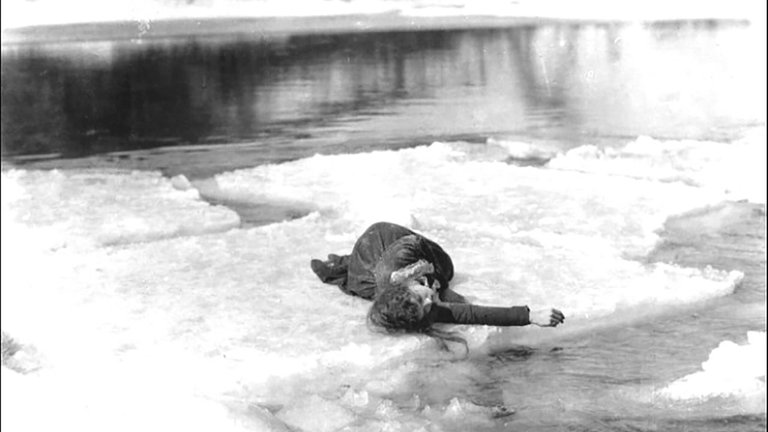Film Review: Way Down East (1920)

If we are to compare Hollywood today with the Hollywood a century ago we would notice that the biggest difference, apart from obvious technological issues like the lack of sound and colour, is the increased level of melodrama in the content of old Hollywood films. There are many reasons for that, mostly having to do with the tastes of early 20th Century audiences. In any case, a lot of melodramas were being filmed and such quantity resulted in some high quality melodramas. One of the most celebrated was Way Down East, 1920 film by D.W. Griffith, now known as one of the silent classics and among the best remembered films of that director’s prolific filmography.
The film is based on the eponymous 1898 play by Lottie Blair Parker, which was big hit on Broadway. The protagonist is Anna Moore (played by Lilian Gish), innocent girl from rural New England who is sent by her mother to Boston to seek money from their cousins. She ends at high society ball where she catches attention of Lennox Sanderson (played by Lowell Sherman), playboy from rich family. He easily seduces her by paying some shady characters to perform mock marriage. After spending “honeymoon” in hotel room, Anna is sent home and only later realises that she was deceived. She was also made pregnant and forced to leave home after her mother’s death. Later her baby dies and Anna, desperate and destitute, ends in village of Bartlett. She seeks job at the farm run by God-fearing Squire Bartlett (played by Burr McIntosh) who is at first reluctant to accept her. Anna, who was quiet about her tragic past, is ultimately hired and becomes beloved member of household, especially for Squire’s young son David (played by Richard Barthelmess) who has fallen in love with her despite being expected to wed his beautiful cousin Kate (played by Mary Hay). Anna gets in trouble when it turns out that Lennox is Bartletts’ neighbour and that he would like to see her out of the house, especially since he wants to seduce Kate.
Parker’s play was big hit in its time but when Griffith decided to adapt it to big screen it was considered to be old-fashioned, mainly because of its extensive sentimentality and insistence of Victorian values which were becoming difficult to reconcile with more laid back hedonistic mores of emerging Jazz Age. Griffith, however, wasn’t discouraged and as the most successful and respected of all American film makers at the time he invested great deal of effort, money and talent to make the old content look fresh and impressive through new medium of motion picture. Despite ordinary everyday setting, Way Down East was one of the most ambitious and expensive films in Griffith’s career with epic running time of almost two and half hours. Griffith showed great skill although the film didn’t feature much of technical innovations. Almost all shots are static, but Griffith effectively uses close up and cross-cutting of various scenes. Griffith’s mastery is most visible in the famous scene near the end where David jumps over ice floes in order to rescue unconscious Anna before ends in waterfall. The scene, done without stunt people in the middle of winter is one of the most impressive and most iconic in the history of silent cinema and is as exciting for audience today as it was a century ago.
However, in order to appreciate it, viewers would have to sit through many scenes that look mediocre in comparison. That also includes Griffith’s intertitles which he uses to preach conservatives values to audience and promote Christian virtues. Conservative stance of Way Down East can be seen in sharp contrast between depiction of big city, ruled by decadence and various shady characters on one side and unsophisticated but quiet and happy village on the other side. Griffith uses this dichotomy also to inject humour in Way Down East and thus temper overtly melodramatic and sometimes even tragic content that would otherwise make this film insufferable. This is achieved through depiction of many eccentric and picturesque characters around Bartletts, played by very talented set of actors. But the biggest star is, of course, Griffith’s great muse Lilian Gish. She again puts features of new medium to good use, both by her angelic expressive face and incredible acting ability that makes her character believable even in the corniest of all scenes. Richard Barthelmess, who was paired with Gish a year earlier in Broken Blossom, also delivers good performance due to good chemistry with lead actress.
Way Down East, however, could never be in the same league with other grand works of Griffith. And there is one very simple but unpleasant reason for it. Many scenes of the original film are missing, being lost like with so many films of silent eras. Most versions shown today are instead using added narration or still photographies, creating effect that would be offsetting to all but the most hardcore cinephiles. On the other hand, those who appreciate good melodrama while having patience and understand for technical issues would probably be pleased with this film. In 1936 Way Down East had sound remake starring Henry Fonda.
RATING: 6/10 (++)
Blog in Croatian https://draxblog.com
Blog in English https://draxreview.wordpress.com/
Leofinance blog https://leofinance.io/@drax.leo
Cent profile https://beta.cent.co/@drax
Minds profile https://www.minds.com/drax_rp_nc
Uptrennd profile https://www.uptrennd.com/user/MTYzNA
Unstoppable Domains: https://unstoppabledomains.com/?ref=3fc23fc42c1b417
Hiveonboard: https://hiveonboard.com?ref=drax
Bitcoin Lightning HIVE donations: https://v4v.app/v1/lnurlp/qrcode/drax
Rising Star game: https://www.risingstargame.com?referrer=drax
1Inch: https://1inch.exchange/#/r/0x83823d8CCB74F828148258BB4457642124b1328e
BTC donations: 1EWxiMiP6iiG9rger3NuUSd6HByaxQWafG
ETH donations: 0xB305F144323b99e6f8b1d66f5D7DE78B498C32A7

https://twitter.com/21393347/status/1644953899831361537
The rewards earned on this comment will go directly to the people( @drax ) sharing the post on Twitter as long as they are registered with @poshtoken. Sign up at https://hiveposh.com.